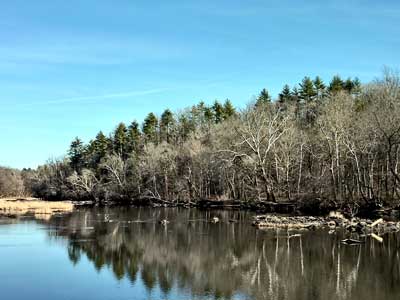New Year’s resolve for weekly explorations
By Ken Moore
Flora Columnist
This time every year, I encourage folks to resolve to walk a trail through local natural areas at least every weekend, beginning with New Year’s Day. That notion was long ago inspired by the Eno River Association (enoriver.org) New Year’s Day Hike. Subsequently, there are guided hikes along the Eno every Sunday through the end of spring.
You can avoid crowds if you plan your own walk. A good website to get you started is ncnatural.com/TriangleRec
When Citizen publisher Robert Dickson told me that he and his wife, Vicky, were going to explore the White Pines Preserve on Christmas Eve, I responded: “Wow, that area at the confluence of the Deep and Rocky rivers south of Pittsboro is one of my favorite places and I haven’t explored it in years! Take some pics for me.â€
Robert’s image of the icy pattern surrounding the moss-covered knee of a submerged log was just one of several appealing “closer looks†that he shared.
Vicky’s verbal image of the day’s hike was equally engaging: “There’s just something about a river – water that comes from somewhere else, and goes somewhere else – that’s awe inspiring. And the confluence of two rivers, like the Rocky and Deep, is even more so.
“The stark white sycamores at the edge of the river, the rusted cable that once was part of the bridge kids crossed to go to school, the high bluffs over the river and the silver and rainbow-colored ice that traps the river at its margins are all brought into vivid relief by the starkness of the winter landscape. Your attention is drawn to things you might not notice in any other season.â€
Kathy Buck and I followed in Vicky and Robert’s footsteps at the preserve on Christmas Day. We were impressed with the extensive forest of evergreen American hollies, some heavily berried, and most festive at this special winter solstice time. Medieval druids would be happy here.
The occurrence of white pines, Pinus strobus, 75 miles east of their normal range, is the special natural feature that led to the White Pines Preserve becoming the first of the Triangle Land Conservancy’s several preserves.
Download the preserve guide and map (triangleland.org) before you go. The map will keep you oriented as you explore.
Walking beneath the mature pines, noticing seedlings growing here and there beneath them, one can pause to consider that these characteristic mountain plants are relics isolated here following the retreat of the last glacial period 10,000 years ago. Specific environmental conditions of temperature and moisture, critical for survival of the species, still exist along the steep slopes at the confluence of the two rivers.
You can distinguish white pines from the preserve’s dominant loblolly pine, Pinus taeda, if you look for long narrow cones (like a short banana), bluish-green needles that occur five to a fascicle (bundle), tree limbs in whorls around the main stem, like the spokes of a wheel, and smooth dark bark.
Our Christmas Day walk was rejuvenating; I hope we will manage such an outing every week in 2011.
Celebrate this New Year with your own exploration of the White Pines or some other natural area, and resolve to explore a different place every weekend.
Email Ken Moore at flora@carrborocitizen.com.


Comments are closed.